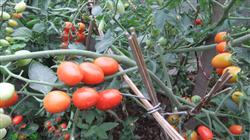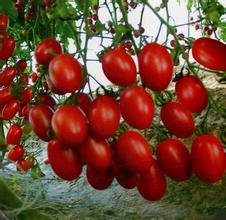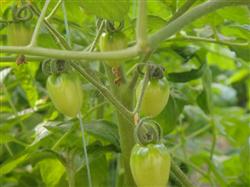Early planting techniques of Virgin Tomato in Spring

Saint tomato, originated in Taiwan, is a cherry tomato, mainly to eat fresh fruit, to be called saint fruit. Early cultivation in spring, can use a span of 6 meters of plastic greenhouse, seedlings in mid-November, the next February planting, early May harvest fresh fruit, yield 6000 kg fresh fruit per mu. 1. Seed treatment. In order to prevent the seed from spreading with bacteria, the seed should be disinfected before sowing, and it can be soaked in warm soup or medicine. Soaking the seeds in warm soup is to soak the seeds in cold water for 10 minutes, then put them into hot water at 50-55 DEG C, stir them rapidly continuously, heat the seeds evenly, supplement hot water at any time, stabilize the temperature of water, take them out after 15-20 minutes, put them into cold water to dissipate residual heat, and then soak them in warm water at 25-30 DEG C for 4-6 hours. The seed soaking method comprises the following steps: wrapping the seed with gauze, soaking the seed in 10% trisodium phosphate aqueous solution for 20-30 minutes, then taking out the seed, wrapping the seed with wet towel, and placing the seed at 25-28 DEG C for germination. During germination, the seeds are washed 1-2 times with warm water of about 25℃ every day, and germination is accelerated after 2-3 days. When 50% of the seeds are exposed, they can be sown. 2. Sowing seedlings. First, the prepared seedbed is watered, after the water seeps for 2-3 hours, the seeds are evenly sown, and then 0.5-1 cm of nutrient soil is covered, the seed amount per square meter of seedling bed is 3-5 grams, and the planting area per mu needs 8-10 square meters of seedling bed. Cover with plastic film after sowing for heat preservation and moisture retention, and remove the film immediately after emergence. The management from sowing to cotyledon emergence of cherry is mainly to create suitable environmental conditions for seed germination and emergence, so as to achieve the goal of seedling uniformity, seedling integrity and seedling strength as soon as possible. 3. Transplant seedlings in due time. When the cherry has 1 leaf and 1 heart, transplant it to the nutrition bowl at noon on sunny days. Nutrient soil is mainly composed of fully decomposed organic fertilizer, and appropriate increase of phosphorus fertilizer and appropriate application of nitrate nitrogen fertilizer. In order to ensure adequate nutrient area, it is best to protect the roots with a 9 cm x 9 cm nutrient bowl. The principle of seedling bed management during cherry seedling period is to have proper temperature, humidity and sufficient sunshine. Through covering heat preservation, removing film for light transmission, watering and fertilizing, and expanding the spacing of nutrient bowls, etc. IV. Planting. When seedlings grow 7-8 true leaves, they can be planted (with buds). Double row planting is carried out in each plot, with small rows of 60 cm and plant spacing of 40 cm, and 2000 plants are planted per mu. The planting depth should be at the level of cotyledon position, and the planting water should be poured thoroughly. Cover with plastic film after planting. Cut the film according to the length of the ridge surface and the length of both ends buried in the soil, then put the cut film between two rows of seedlings, then pull the film horizontally to both sides of the ridge, and finally tighten and compact. Field management, such as watering, topdressing, temperature management, uncovered greenhouse film, etc., is the same as conventional tomato early cultivation in spring. Diseases and insect pests are relatively light and can not be controlled. 5. pruning. Cherry grows rapidly in the greenhouse, the plant is tall, erect sex is poor, when the plant grows to 30-40 cm, should insert pole tie tendril or hang wire traction, in case of lodging. Branch growth force is strong, can use multilayer to add successive 2 layers to pinch pruning, namely keep the inflorescence on the trunk, leave the branch on the trunk, leave 2 inflorescences on each branch, and then leave 2 leaves on the inflorescence to pinch. To cut branches and twist branches in time, so that branches do not shade each other, twist branches generally in sunny days, timely remove the yellow old leaves and sick leaves to reduce nutrient consumption and enhance light transmission. 6. Keep the flowers and fruits. In early spring, when the temperature is low, the flowers are easy to drop due to poor pollination. The newly opened calyx and flower stalk can be smeared with 2,4-d (marked with red advertisement color), or the more orderly inflorescences can be dipped in 2,4-d solution. VII. Harvest. Due to the high sugar content of cherry tomatoes, only when fully ripe harvest can truly reflect the inherent flavor and quality. Therefore, it should be harvested properly. The sepals and a fruit stalk should be preserved when harvested.
- Prev

Continuous coring and pruning of small tomato
Tomato is a creeping crop, but it is often cultivated vertically by introducing frame in cultivation. Therefore, with the growth and extension of the plant, the farther away from the ground, the effect of flowering, fruit setting and fruit expansion is less ideal, and the yield can not be increased. In view of this bad situation, the continuous coring method can be used to make.
- Next

Cultivation techniques of Cherry Tomato in Solar greenhouse in Winter and Spring
Cherry tomato, also known as mini tomato, contains a variety of vitamins, inorganic salts and so on. Like ordinary tomatoes, cherry tomatoes are not resistant to cold and heat. Ordinary and excellent solar greenhouses can be used in winter and spring, usually sowing from late October to early November, planting from mid-January to early February the following year, and listing from early and middle March to June.
Related
- Moge, come on! The staff of the peasant association in the producing area of cantaloupe were frightened when the crowd gathered.
- Causes and Solutions of low Fruit setting rate of Apple
- Symptoms and control measures of passion fruit virus disease
- Fruit growing lesson: how do apple orchards keep high yields?
- Can you build orchards in the mountains? What are the pros and cons?
- How to manage the coloring period of Crisson grape?
- This paper introduces the processing technology of two kinds of fig products.
- How much is a month for retired teachers in rural areas by 2020?
- How can strawberry planting increase sugar content? We should pay attention to management in many aspects.
- What are the cultivation techniques on how to improve the yield of golden fruit?

